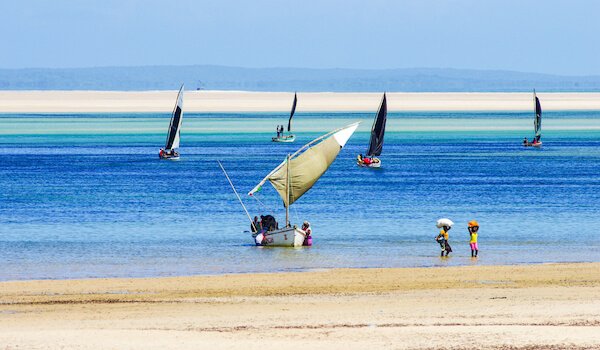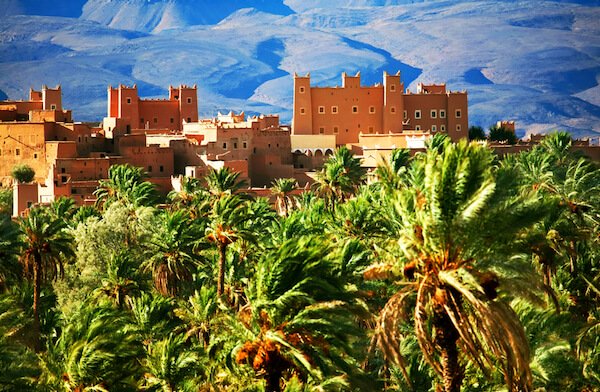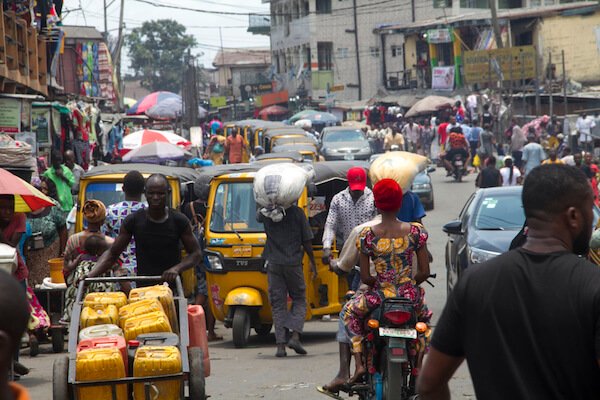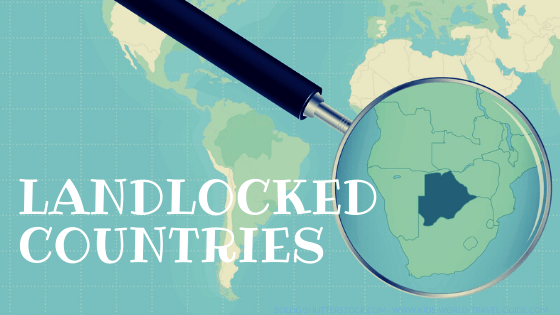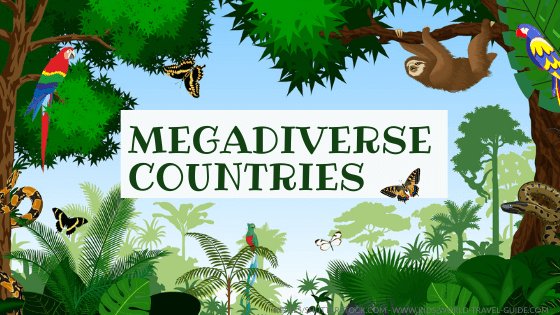- Homepage
- Namibia
Namibia Facts
These Namibia facts were chosen and researched by kids especially for kids to get more insights into this beautiful country.
 Namibia is know for its huge Namib desert and wildlife
Namibia is know for its huge Namib desert and wildlifeInteresting Namibia Facts for Kids
 Namibia Flag
Namibia Flag- Name: Republic of Namibia
- Population: 2.6 million people (2022)
- Capital: Windhoek, which means 'windy corner' in the Afrikaans language, is the country's largest city with 450,000 inhabitants.
- Nickname: 'The Land of the Brave'
- Government: Republic
- Literacy Rate: 91.5% of all adults can read and write
- Language: English (official language), and 132 other recognised languages such as Oshivammbo, Nama/Damara, Afrikaans (spoken by most of the population), German (as Namibia was formerly a German colony) and several African languages
- Religion: over 80% Christians (more than half of the people belong to the Evangelical Lutheran Church)
- Currency: 1 Namibian Dollar (NAD)= 100 cents
- Unemployment: 34.3% of the people are jobless.
- Independence Day: March 21. Namibia gained independence only in 1990
Where is Namibia?
The country is located along the Atlantic Ocean in Southern Africa.
Namibia shares borders with four countries: South Africa in the South, Zambia and Botswana in the East and Angola to the North. The longest border is shared with Botswana.
Namibia has a desert climate which is hot and mostly dry all year round.
 Map of Namibia
Map of NamibiaA flight from London/ England to Windhoek takes about 11 hours and a flight from Johannesburg/ South Africa takes about 3 hours. From the USA, Namibia is reached usually via Frankfurt/ Germany and it takes usually two days to reach this destination.
Namibia Facts:
Namibia Geography
Namibia is almost as big as half of Alaska, pretty huge! And the vast country is almost as sparsely populated as is Alaska and is the second sparsely populated country on the African continent, after Western Sahara.
The most parts of the country lie on a high plateau. The central plateau is over 2,000 m/ 2,650 ft high and borders the Skeleton Coast with the Namib Desert in the West, the Orange River in the South and the Kalahari Desert in the East.
 Dunes landscape in the Namib desert
Dunes landscape in the Namib desertThe Namib Desert stretches along the Atlantic ocean over 1,000 km/ 621 miles with huge dunes as far as the eye can see. This desert is considered the oldest desert in the world and has been arid (dry condition) for more than 55 million years. The Namib also has some of the highest dunes in the world.
The Kalahari Desert stretches along the eastern border of the country and is varied in vegetation. Some parts are very dry and desert-like whereas others have more grassland and mountainous and rocky regions.
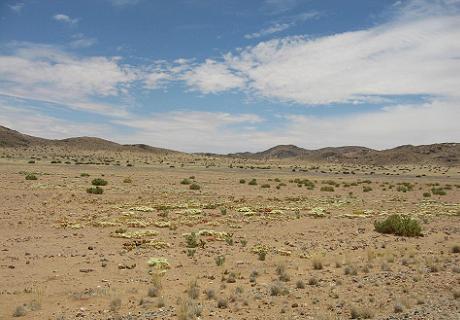 Driving through Southern Namibia
Driving through Southern NamibiaThe highest mountain in Namibia is the Brandberg mountain ('fire mountain') with its highest peak called Königstein (which is called 'king's peak' in English, actually the name comes from the German and would mean king's rock!) with 2,606 m/ 8,550 ft.
Namibia was the first country to sign a statement that includes the protection of the environment into the country's constitution!
 Fish River Canyon
Fish River CanyonThe most important rivers in Namibia are the Zambezi River, the Orange River, the Okavango River and the Fish River.
Fish River Canyon is in fact the second largest canyon in the world - after the Grand Canyon in the USA.
Namibia Facts | Animals in Namibia
In Namibia you can enjoy seeing plenty of wild animals, whether you are visiting places in the desert, close to the Atlantic Ocean or in the bushveld. The Namibian National Parks and Game Reserves are especially good for viewing some the wildlife in Africa.
 Animals around a Waterhole in Omaruru
Animals around a Waterhole in OmaruruOn this photo you can see lots of animals that came to drink at the waterhole at sunset. We captured this image at the Omaruru Game Lodge, which is located in the centre of Namibia.
Read more about animals in Namibia when you click here or on the image below.
Namibia Facts | Namibia People
Namibia is a multicultural country as there are many different cultural groups living in this region. Namibia once was a former German colony, and you will encounter still many Germans here.
Some towns like Swakopmund, Lüderitz and Walvis Bay will still display German names and signs on shops or name German dishes on menus that are written in German, but will also be able to hear quite a few people communicating in German when out and about.
 Herero woman with children
Herero woman with childrenThere are many different people sharing the land, of which there are the Herero, the Nama, the Himba and Kavango or the San Bushmen are the largest groups, but there are many others. In the photo above, you can see a Herero woman dressed in traditional clothes, donning a special headwear. These women tend to wear many layers of skirts.
The Owambo which live mainly in the northern parts of Namibia, are the biggest ethnic group. More than half of all Namibians belong to the Owambo people.
Interesting Language Facts
Several indigenous African languages are spoken as home languages in Namibia. Oshiwambo is the African local language which is most widely spoken and understood. This is how you can say 'hello' to the locals (in German, in Oshiwambo and in 'Namibian' English):
Even though English is the official language in Namibia, many people are more comfortable with speaking Afrikaans or German as they learned it in school.
About one third of Namibians still speak German because Namibia as South West Africa was settled by German immigrants in the last century and many families were influenced by the Germans as they worked and lived together in rural areas.
Namibia was a German colony between 1884 and 1915 and after this, was named South West Africa and ruled by South Africa until Independence in 1990. Many Namibians therefore now speak Afrikaans at home. Afrikaans is one of the official languages in South Africa.
Namibia Facts | Namibia Food
There is a wide variety of food available in Namibia with the ocean supplying fish and seafood and the farms in the countryside providing lamb, beef and ostriches.
There are as well exotic sounding game dishes made with with kudu and springbok meat in form of steaks, fillets or as ingredient in a typical potjiekos or stew.
 Potjiekos
PotjiekosThe most commonly known dishes are:
- pap: porridge made with cornmeal, usually very thick so it can be eaten with the hands
- potjiekos: slow cooked stew made with a variety of vegetables and meat in a heavy cast iron pot, made usually over the open fire.
- braaivleis: grilled BBQ-meat
- Mopane worms: crispy fried caterpillars
- kapana: grilled meat strips, usually sold in townships or in street markets, can be made with any kind of meat
Namibia Attractions:
What is great to visit in Namibia?
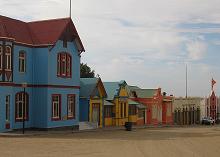 Colourful colonial houses in Lüderitz
Colourful colonial houses in Lüderitz- Lüderitz and Swakopmund: Explore the colonial history
- Orange River and Fish River: Canoe or hike in the canyons
- Windhoek, the capital city: Visit museums and learn about the countries history, culture and geology and admire the meteorites on display in the pedestrian zone
 Kolmanskop - former German colony in the desert near Lüderitz
Kolmanskop - former German colony in the desert near Lüderitz- 'Ghost Town' Kolmanskop: Go back to 'Diamond Fever' time of the former German colony
- Etosha Pan and the North: Great for wildlife viewing
- Soussousvlei and Kalahari: Desert and dunes as far as you can see
 Dunes with Oryx
Dunes with OryxInteresting Namibia Facts
 Oryx antelope
Oryx antelopeDid you know…?
...that Namibia is the second least densely populated country on earth? Only Mongolia is more deserted but it's bigger in size!
Namibia Facts | References
- Central Intelligence Agency. "Namibia." CIA World Facebook. Last edited 5 January 2022 Last accessed 7 January 2022
- Info Namibia. "Fish River Canyon." InfoNamibia. Last accessed 7 January 2022
- Kingfisher Geography Encyclopedia Africa, Namibia, (London: Macmillan 2008), p.43
- National Geographic (eds.) Africa Adventure Atlas. (Cape Town: map Studio, 2008)
- The Children's Visual World Atlas, Namibia, (Sydney: Fog City Press, 2004), p. 140-143
- The 100 Most Beautiful National Parks of the World, Namibia (Lisse: REBO Publishers, 2007), p. 190
We hope you enjoyed our Namibia Facts for kids and will visit again. More Namibia Facts will be added soon.
Image Credits: own images and shutterstock.com
Popular Pages
Competition 2024 is open!

Africa Facts
More Countries in Africa
 Tanzania
TanzaniaDid you like what you read?

|
Would you like a link to share the information with your friends, fans and readers? Simply use this: <a href="https://www.kids-world-travel-guide.com/namibia-facts.html">Kids World Travel Guide: Namibia Facts for Kids</a> |



















